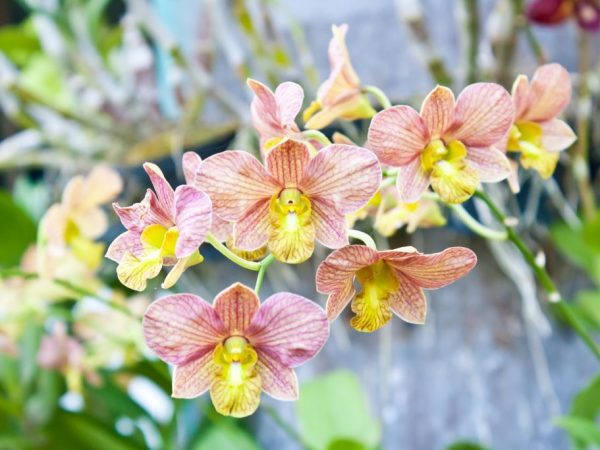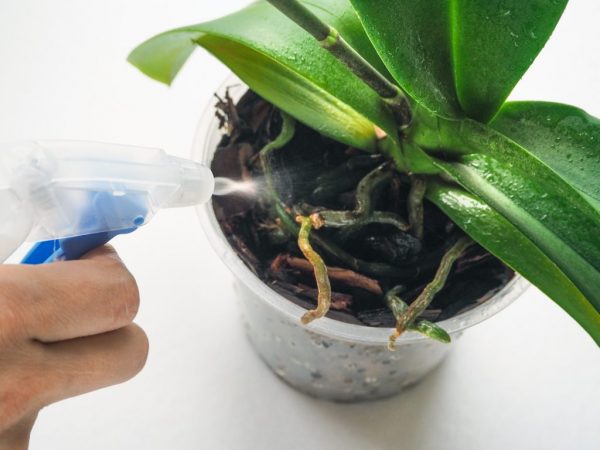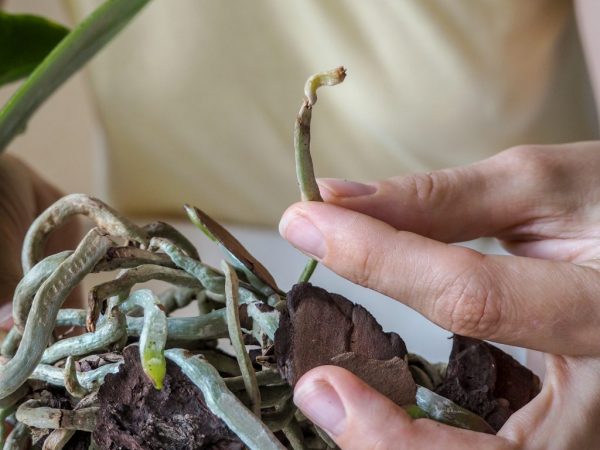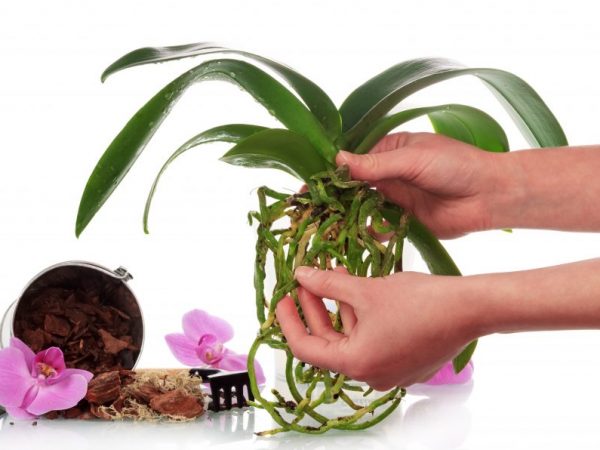Care for a faded orchid
Florists put all their efforts to make the grown orchids bloom with bright, beautiful buds. But what to do when the orchid has faded? With proper and organized care, there is a chance to achieve stimulation of the re-formation of flowers. There are several methods for performing this procedure.

Care for a faded orchid
What to do with the plant after flowering
The orchid, depending on the type and characteristics of the content, blooms several times per season, therefore, one of the options for action in the event of a plant dumping buds is the inaction of its owner. After coming out of a dormant state, the plant often creates a lateral shoot, the growth and development of which leads to the formation of new inflorescences.
Weak or young orchids are pruned. Cymbidiums and oncidiums need trunk renewal. Chemical methods of stimulating the reappearance of flowers can also be used.
Stimulation of re-flowering
There are a number of ways to revitalize a plant by stimulating it to bud again. The safest methods for orchids are those that cause stress on the flower. For a while, watering and feeding the plant is excluded, or they arrange temperature hardening for it.
If these methods are ineffective, chemical stimulation is used. The most popular remedy is cytokinin paste.

Ways to stimulate bud re-shaping
Artificial stress
In order for the orchid to begin to bloom again, the method of artificially introducing the flower into a stress state is used. At home, when the orchid has faded, they stop watering and fertilizing, and also lower the temperature of the content from 22 ° C-24 ° C to 18 ° C. The operation time depends on the condition of the flower and its characteristics. After 3-4 weeks, they return to the usual care regimen. Changing the conditions of detention awakens her and forces her to form shoots with inflorescences.
Quenching is also used. Its peculiarity is in changing the day and night temperature regimes. The difference between them should be 5 ° C-6 ° C. That is, the orchid is taken out to the balcony every evening, and returned to its place in the morning.
Chemicals
Resuscitation of a fading orchid with Cytokinin paste is effective only if the flower has strong immunity, its roots are strong and do not suffer from rot.
Before using this remedy, you should examine your pet for dormant kidneys. The best option would be the uppermost and lowermost kidney (if they are not there, the arrow will have to be removed). The process of stimulating re-flowering is as follows:
- Remove the top skin from the kidneys with a sharp knife.
- Squeeze a ball of paste (up to 2 g) onto a toothpick or needle.
- Treat naked sleeping kidneys with a product.
With a well-performed procedure, babies appear in 7-10 days. The shoots obtained are used for culture propagation. They are rooted subject to the presence of dormant buds.
Another popular remedy is succinic acid solution (1 tablet per 250 ml of water). The roots of the flower are dipped in the product for 3-4 hours. The procedure is carried out every 3 weeks. The method is effective only if the plant has a dormant bud.
Trim dry arrowhead
If, after the Phalaenopsis has faded, the trunk dries up, losing its color, it is removed. Do not worry that the plant will not survive after the work done on the peduncle. Flowers, when pruned correctly, are safe and do not suffer. The procedure is also necessary for young plants to restore the growth and development of the root system and leaves.
Parting with a peduncle should be when certain signs appear. If Phalaenopsis or Dendrobium Nobile has a brown stem, it's time to take up the tools. It is better to cut off the branches with an ordinary sharp knife or scissors, pre-treated with an alcohol-containing solution. A faded orchid with a dried stem is pruned like this:
- Cut off the stem, leaving a process of 1-1.5 cm.
- The cut site is treated with beeswax to seal the wound, protecting the plant from water ingress during further watering.
- The flower pot is placed in a permanent growing place and proper care is organized.
A faded orchid in the presence of a dormant bud is cut according to a different scheme.
The peduncle is cut at a distance of 1.5 cm from the sleeping eye. Depending on the quality of the subsequent home care, the flower arrow will grow and stimulate the appearance of beautiful and fragrant flowers.
Premature drying of the peduncle
The peduncle is a temporary shoot of a flower. Its life is characterized by 1-2 flowering periods. Premature flowering ends are rare. If Phalaenopsis quickly faded, this indicates poor plant immunity, its unpreparedness for budding.
If the orchid has faded prematurely, the condition of the plant's roots is checked. They should not be wet or moldy. Healthy roots are firm, green. The damaged root system is trimmed, removing all areas affected by rot, and also transplanted into a new substrate.

If the orchid has faded prematurely, the condition of the plant roots is checked.
Resting care
When the orchid has faded, proper care is organized for it, allowing it to maintain the vitality of the flower arrow and get abundant flowering. It has its own characteristics:
- Organization of watering. It is halved. All excess moisture is removed through the drain. Stagnant water, especially in winter and spring, leads to hypothermia of the root system and the formation of rot on it.
- Spraying. It is minimized or completely abandoned. It is better to put a container of water next to the pot, which helps to humidify the air in the room.
- Top dressing. They are stopped before the plant awakens.
- Temperature. It is organized within the range of 22 ° C-23 ° C during the day and 15 ° C at night. Under such conditions, optimal conditions are created for the qualitative appearance of the arrow, the formation of inflorescences and their pollination.
To organize the correct microclimate at night, open the window. This is not done only at sub-zero temperatures. The effect of frost on the roots and stem of the plant is destructive. The flower suffers from frostbite and dies.
The plant should also be taken care of in winter, when it needs additional highlighting. Without light, the foliage of the flower will dry out quickly, and as a result, the stem will not bloom again. Phytolamps with a capacity of no more than 60 watts are placed next to the orchid.
The plant comes out of dormancy on its own. A sign of the end of hibernation is the appearance of young roots and leaves.
Transplant after flowering
The purchased orchid, which has already bloomed, is transplanted into a new pot. At the end of flowering, the plant goes into a dormant state. This is the most favorable time for such work.
The need to transplant a faded orchid is determined by various factors. The reasons for planting a plant in a new pot are:
- active development of the root system - the plant is cramped in an old pot;
- deterioration of the properties and quality of the substrate;
- affected plant roots;
- parasites.

An orchid that has faded is transplanted into a new pot
Without the need to transplant at home, it is risky: the plant does not tolerate a change of place of detention, which is why there is a risk that onony will stop growth and development. You cannot keep an orchid in one pot for more than 3 years.
Transplant time is limited to the spring months. The kind of culture also has its own characteristics. Oncidiums and Cattleyas are transplanted with the appearance of a new sprout on the flower, before it takes root, Dendrobium Nobile and other Phalaenopsis - when fresh shoots appear at the roots.
It is better to purchase new primer at any specialized store. Granular formulations are very popular. Making the substrate yourself by mixing sphagnum moss and pine bark is also easy. The transplant process goes like this:
- The plant is removed from an old pot, the roots are shaken off and soaked in water for 20 minutes.
- Drainage is placed in a new pot: charcoal, expanded clay, etc.
- The roots of the flower are laid on top of the drainage and sprinkled with a layer of soil.
A pot with a flower is placed by the window, providing it with diffused lighting. Watering is carried out after 2 days.
Conclusion
A faded orchid, depending on the type and care that a person provides for it, has a chance to bloom again. There are several options for working on a dormant shoot that will help restore flowering. Parting with a flower arrow should only be when it is completely dry.


